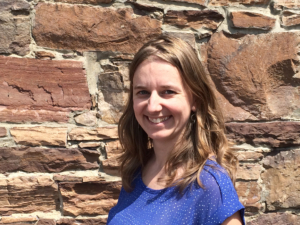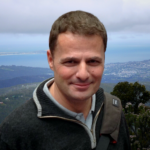
Which door are you going to choose?
Talking about climate change is not an IF question anymore, it is a HOW question. Thankfully, there are many ways to get started.
Alexandra Arnold| USA
Alex Arnold (she/her) MSPsy, MSHR/ OD, ACC, is program director at The Taos Institute and a climate resilience coach at Alma Coaching, where she uses positive psychology and Appreciative Inquiry to help introverted and highly sensitive people shift from climate anxiety to inspired action.
Over the course of the month of March 2023, the Climate Coaching Alliance Global Festival featured more than 50 virtual events on the theme: Tools for Transitions – Navigating the Paradoxes, Polarities and Paradigms in Climate Coaching. Sessions were hosted by people from around the globe on topics that go far beyond traditional news headlines, alarmist messages, or the most common calls for action. In this article, we will explore the wide variety of ways one (whether a coach or not) can start climate conversations, at home, at work, and with oneself. Let’s see what happens when we open some of these doors …
(Most gatherings started with a grounding exercise and lighting a candle, which you may want to do before you read on, allowing yourself to slow down and honor your own experience with this topic.)
Door #1: Gut microbiome
When it comes to climate change, the scale of the problem can make us feel very small, as when we stand in a forest surrounded by really tall trees, looking up. Cara Wheatley-McGrain, host of the session Compassionate connection to our inner and outer ecosystems, invited us to look down instead: at the fallen leaves, the earth, the small creatures and plants on the ground, and to consider that, from this perspective, we are standing on the rooftop of a whole world. Indeed, there are more microbes in a teaspoon of soil than there are people on the earth! It is with this vantage point that Wheatley-McGrain guided her audience through a visualization to visit the garden of their guts, which hosts the largest bacterial ecosystem in the human body. We’ve all heard the term “gut feeling”, and for a good reason.
Recent research on psychobiotics led by Professor John Cryan suggests that our gut health is not only linked to our physical, but to our mental, health. When it comes to microbes and bacteria, our gut thrives on abundance, diversity and balance. Unfortunately, in addition to being the principal cause of habitat loss (in turn contributing to species extinction), the industrialization of our food system has been leading to an invisible extinction of our gut microbiomes. A conservative estimate is that modern city dwellers have lost around 50% of their microbes through urbanization. If it is sometimes hard to relate to larger ecosystem changes taking place due to climate change, looking – or rather feeling – right inside of our guts may be a powerful motivator for positive change.
Door #2: Conscious influence
Many of the ideas brought forth by Stephanie Trager in her session entitled The Art of Conscious Influence for Change Agents will sound familiar to Appreciative
Inquiry practitioners. Rather than taking a “fix it” attitude, she calls for a reverse engineering process by asking “What is the future asking of us? What does that energy feel like?” Visualization, non-linear perception, and using a vocabulary of increase are tools that can replace the current narratives that keep us stuck with the constructs that got us where we are in the first place. By using other tools, we clear ourselves on the inside so that we can emanate conscious influence, or positive energy frequency. Check out Dr. David Hawkins’ map of consciousness to find out what emotions you want to cultivate to create the highest frequencies, life energy or level of enlightenment. Doing so, as Trager said in her session, “in ourselves and others, is the most accelerated path to a thriving and sustainable world … As conscious influencers, we have a deeper ripple impact from the inside out, through power versus force.”
Door #3: Cosmology
Cosmology is the study of the origin and structure of the universe. For Drew Dellinger, host of Planetizing the Movement with the Powers of Dream, Story, Art, and Action, cosmology is also a worldview, a story of separation of humans and nature that has been dominating a large part of the world. “How do we move from a cosmology of exploitation to one of interconnectedness?” he asks.
Or, as cultural historian Thomas Berry puts it, “from viewing the universe as a collection of objects to a communion of subjects”. One way, Drew Dellinger suggested in his session, is to bring the arts back from the fringe to the center, to remember that art is how heart speaks to heart; it is essential to who we are, and we are all artists in our own way. Art has a central place in activism. Art puts pressure with joy and love. Slowing down, being in stillness, spending time alone, and meditation can be ways to activate our innate creativity and perhaps even connect with the wisdom of the universe.
Other topics included: How we can draw on indigenous wisdom for the challenges facing us now; Successfully attract your clients to climate action; The self in a zillion eco-transitions; How to become a resilient and confident female leader for climate change?; Preventing climate burnout; Our traumas hold the key to the more beautiful world; How can the 3Cs of inclusive leadership enhance leading for sustainability?; Glorious 2030 – How to guide topic discussions and the building of desirable futures; How can playfulness help unlock climate action?; and many more.
As you can see, ways to enter conversations about climate change are endless, and sometimes quite surprising. Even so, there are common themes that emerged from all of these sessions. Clover Hogan, activist, entrepreneur, global speaker, and only twenty-three years old, captured them in a powerful opening session:
- Acknowledging eco-anxiety (a chronic fear of environmental doom) and ecophobia (an ethical undervaluing of the natural environment that can result in cataclysmic environmental change). In a survey of 10,000 young people, 70% reported being eco-anxious. Denial, grief, sadness, hopelessness, loss of faith in institutions, burnout, confusion, a sense of betrayal … all are now part of the dialogue. But they are not problems to be fixed: they are “beautiful evidence of our humanity”. Processing rather than bypassing these emotions is important, with someone who can hold the space and facilitate empowerment and agency rather than allowing despair to set in.
- Finding community. We can’t do this alone – and we are not alone. We all need to be with others, in a group or an organization, to find validation, motivation, support and accountability. Taking a collective approach also means bringing many voices into the room and genuinely listening to diverse views, especially those that have been largely ignored or suppressed.
Hogan has a special request for the adults who so often instinctively want to remove the pain and suffering for young people. This has to stop, she says, as it only fuels the feeling of betrayal. It’s time to have honest conversations about the reality, the losses and the pain among people of every age. Hold these conversations with tenderness and care to rebuild trust. In her view, “it is intergenerational wisdom and action that will make a difference”.
- Choosing a focus. Too many are stuck because they feel too small to make a difference, think that the system is too broken, or don’t know where to start. Empowerment comes from finding a unique way to contribute. Rather than trying to fix it all, let’s ask “what is the one thing I can show up to solve, where does my impact come from?” Coaches and AI practitioners can play an important role in helping individuals identify the values, skills, unique gifts – the positive core – that will ignite sustainable action and a sense of agency. Here again, it’s essential to team up with others and not try to go at it alone.
- Changing the story. Being exposed to constant stories of disasters around the world in the news and social media is too much. Pointing out that consumption is at the heart of the crisis and asking people to sacrifice their habits and lifestyles is not working. Vilifying those in power is too easy. Relying solely on technology to solve it all is spreading false hope.
Instead, Hogan encourages us to create a compelling message, an invitation for people to be part of something bigger, a reminder that true happiness comes from within, and a celebration of the fact that there is already a shift toward increased spirituality and connection with nature. “How do we make climate action irresistible?!”
The message throughout this month-long festival, across 50 virtual sessions hosted by change agents from around the globe, is loud and clear: we won’t solve the climate crisis with the same people and thinking that created it. It’s time to open up new doors, tell new stories, and pick up new tools. It begins at the personal level and requires a “going back to nature”.
This event was made possible by the dedication and generosity of CCA volunteers and has resulted in a fantastic library of resources. Watch the recordings available on each event page at www.climatecoachingalliance.org/ global-festival-2023 and spread the word.
Intro by Keith Storace
Continuing with another transformational series – in her second article of this four-part presentation, A Practitioners Journey to Living with Climate Change – Alex Arnold shares an overview of the Climate Coaching Alliance Global Festival that was held in March this year. “Which Door Are You Going to Choose?” is a compelling essay that considers three ways to spark climate conversations.


